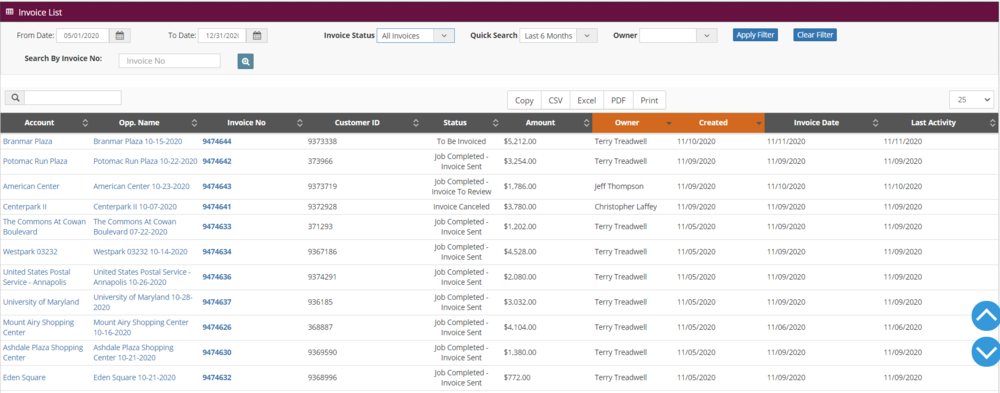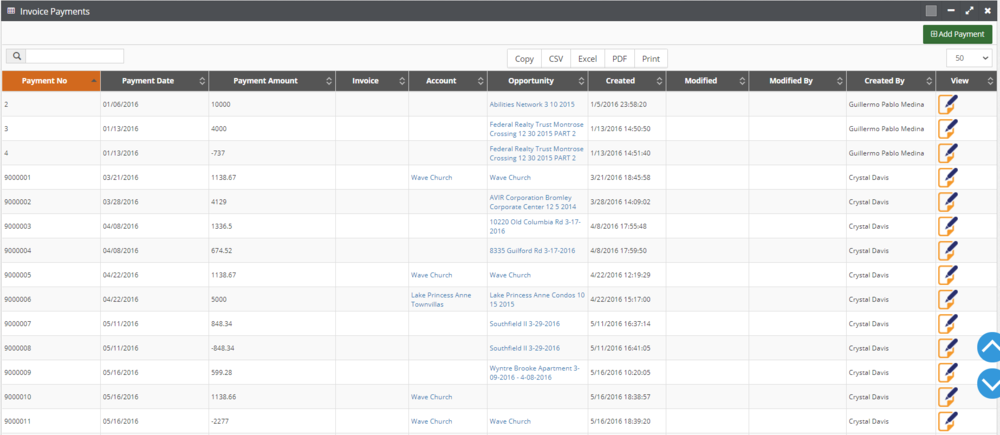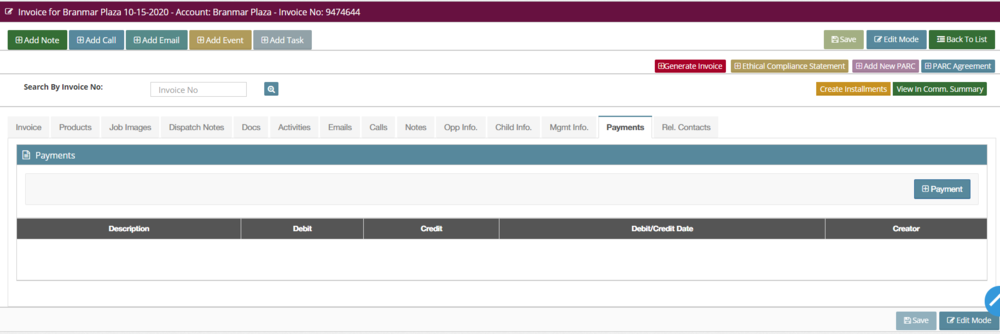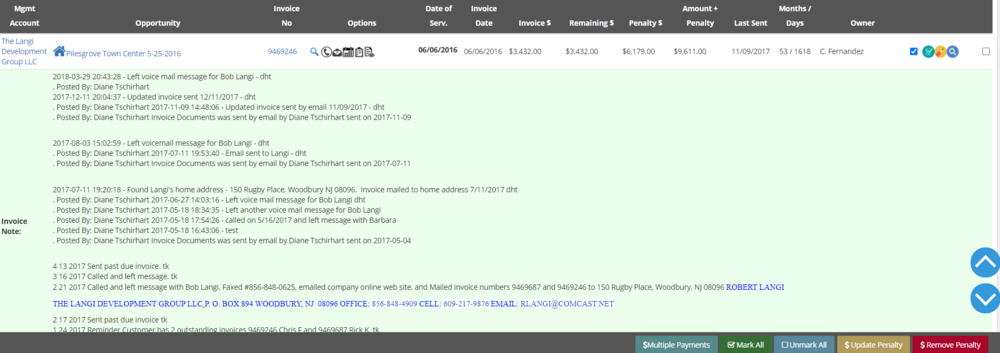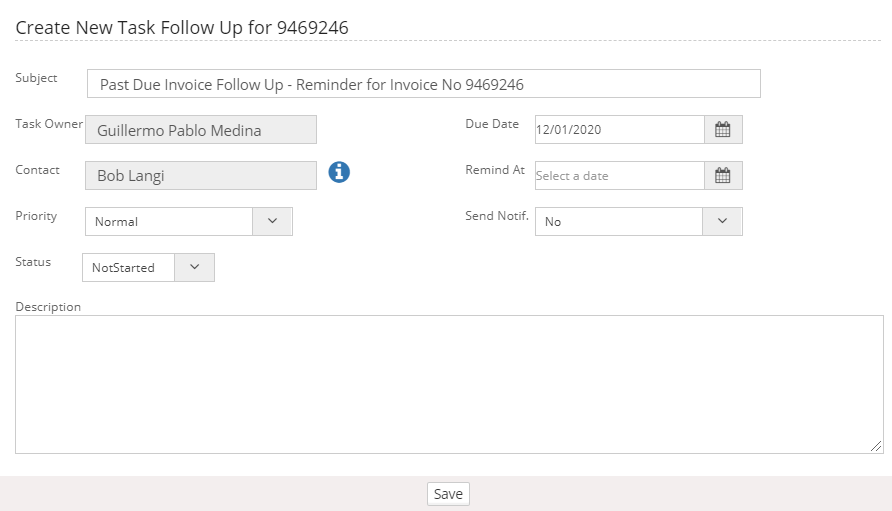Invoices and Payroll
Invoices and Payroll
As you may have realised by now, each module is nothing else than the different parts of a workflow.
When an opportunity is created, it becomes a dispatch. When the dispatch is finished it will give way to the next step. This module, Invoices and payroll, is the last step of the workflow.
We can’t get paid until we get our payments out, that is why this module is related to every other one in the CRM. Once we have the money, the next thing that’s going to happen is the payroll. People need to get paid for their job, salaries, commissions, bonuses, etc.
Invoice Menu
View all invoices
This is the powerpage for the module.
Here the user can access all the invoices ever created in the CRM.
This page works exactly the same as the other modules’s powerpages, therefore filters and search bar work the same way.
Invoice payments
Here you can see deposit payments, these are not full payments.
Sometimes our customers know they will have to pay a big bill, so before the job is done they prefer to put a deposit down.
In such cases, when the invoice is generated, the system detects that deposit and subtracts the money.
Now, if the deposit is big enough to pay the full price, it automatically removes that amount creating a new line on the payment section in the account and the invoice module. It also changes the status of the invoice to “payment received”.
Should there be exceeding money, the system will create a new deposit for the remaining amount. On the contrary, when the deposit is not enough to pay the full bill, it will create a partial payment.
Add invoice payments
This is another section to add a payment. This option to add a payment is the same available at the invoice, under the tab for “payments”
We usually use this section to add a payment when the invoice hasn’t been generated yet. A good example of this would be at the end of the financial year, when a customer would like to pay for our services before a new financial year starts.
This section also allows assigning the payment to either an opportunity or an account. An example could be when a customer sends a cheque to pay 3 different jobs.
The blue button is for selecting the Opportunity whereas the green one is for the account.
Past Due Invoice Report
This is the Past Due Invoice Report, which means that an invoice will appear here for the first time the day after its due date has passed. And the only thing that will make it go away is when it gets paid.
Again here we can use different filters to easily search for an invoice.
You can also see the notes by clicking “Show Notes” at the top right corner of the screen.
So you can look at each one and see what activities have been added. It will also show you when the work was done, when the invoice was sent and the amount of it. It will show you too what is remaining to be paid, whether there is a penalty and how much it is, and how past due it is.
You can update the penalty for the invoice by selecting the invoice and clicking “Update Penalty” at the down right corner.
This will pop up a window to create a new follow up event and notify the customer about their debt.
Finally, there is the same set of actions to add notes, see the documents and more that we have explained before, which are pretty consistent throughout the CRM.
CC Payments Report
This is for Credit Card Payments only.
All invoices paid by credit card will show up here.
The good thing about credit card payments, is that it works with an API that communicates our system with the bank’s server. So every time a customer pays by credit card, it will automatically update the status of the invoice and all records within the CRM, reducing the need of human interaction to manually update the information.
Paid Invoices Report
Once the payment has come in and has been put through the system, it comes in again over this report.
This report is very helpful to aid our accounting software, which is completely separated from the CRM. Is also a nice way to pull the information needed when it is time to pay commissions.
We could say it is like a power page for paid invoices only. It actually works the same way as the power page for viewing all invoices.
Partner Invoices
These work in the same way as the other reports, except this time the report will show those invoices related to an external proposal.
Invoicing process
The invoicing process starts once the dispatch has been delivered and completed by the technicians. So the first step in the process is to check the dispatch.
In order to do this, we need to go to the dispatch dashboard and click on any of the jobs under the section “completed by tech”.
IMAGE I1
This action will take you to the actual dispatch work page.
Here we are going to create the invoice. To do it, click on the “create invoice” button, after selecting the option for “Edit Mode”. Then this action will take us to the next screen, in which we need to control the finished jobs by checking the images of the work performed by our technicians. Here you have a dropdown menu next to each product, which allows you to select the option according to the quality of the job done. When you select the option for “Not Completed” or “Poor Quality”, the system triggers a remedial repair to fix it.
Once everything has been accepted, click again on “Create invoice” at the bottom of the screen to continue with the next step.
IMAGE I2 and I3
After “creating the invoice” we need to continue verifying a few more things.
First, under the tab for “invoice”, we need to verify the contact details of our client.
Here we can see whether the person who is going to receive the invoice is the correct one, and the same applies for the address. We can also specify a different name which will appear in the actual invoice file.
Another important section here is “Invoice detail”, where you can see notes from the account manager and the payment terms. We usually have a Net 10 days term for payment, but of course it can be modified for longer periods if needed.
Remember that most of the information in this tab is auto populated from the Account and Opportunity modules.
Finally, there’s the status. Once this is changed to, “To be invoiced” for instance, the system will generate it. It is not until this moment, that the invoice will be generated in the system.
IMAGE I5 and I6
Next, under the “products” tab, we have to double check what we have sold matches what we have done. If there is a difference, it either means the client didn’t want to repair something or the technicians found some extra repairs and added them. When that’s the case, those added repairs will appear in the product list under the “Additional” line with a tick icon.
IMAGE I4
Once everything has been verified and the invoice created, it’s time to generate the documents that will join the actual invoice.
If the client had bought a PARC Agreement, we would have to add it by clicking the button “Add New PARC”, which is on the top right corner of the screen. This will pop-up a window to fill out the details of the agreement, the same applies to renewing the PARC. This action automatically creates the PARC Inspection Events as well.
IMAGE 11
After that, we can generate the actual PARC Agreement Document, which will be attached to the invoice with the Ethical Compliance Statement too, when it is a new client.
IMAGE 7 and 8
Last but not least, there is an option to “Create Installments”. First, you need to put the amount of installment, then just fill in the due date and save it.
IMAGE 14
Now that we are done, it’s time to finally generate the invoice.
Here we take a final look just to make sure everything is correct and then we save it.
IMAGE 10
Once all this is done, we want to send it to the client. To do it, go to the “Document” tab, where you should find all the documents so far created. Then select those ones you want to send and click on “Send By Email”.
IMAGE 12
The next step will be selecting the right email template. Like we explained in previous modules, the idea of these templates it’s to communicate the right information to our customers.
Finally, after we have sent the email with all the information for our customer, we can consider the invoicing process finished.
IMAGE 13
Cold Weather Repair
The invoicing process during the cold weather program is exactly the same as during normal time, but the difference is that we will be sending the invoice twice. This is because we send a first invoice after the temporary repair has been done, and another invoice 2 or 3 months later once the final repair is finished.
The 2 invoices will be sent regardless if they have been paid or not.
